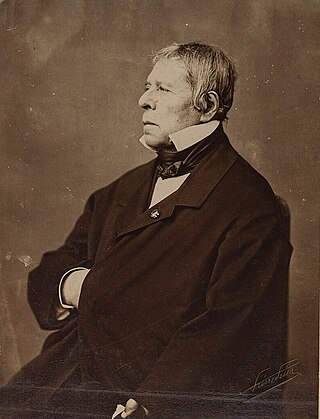
Jean-Auguste-Dominique Ingres was a French Neoclassical painter. Ingres was profoundly influenced by past artistic traditions and aspired to become the guardian of academic orthodoxy against the ascendant Romantic style. Although he considered himself a painter of history in the tradition of Nicolas Poussin and Jacques-Louis David, it is his portraits, both painted and drawn, that are recognized as his greatest legacy. His expressive distortions of form and space made him an important precursor of modern art, influencing Picasso, Matisse and other modernists.
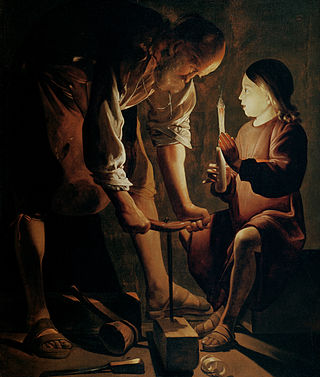
Georges de La Tour was a French Baroque painter, who spent most of his working life in the Duchy of Lorraine, which was temporarily absorbed into France between 1641 and 1648. He painted mostly religious chiaroscuro scenes lit by candlelight.

The Fortune Teller is a painting by Italian Baroque artist Michelangelo Merisi da Caravaggio. It exists in two versions, both by Caravaggio, the first from c. 1594, the second from c. 1595. The dates in both cases are disputed.

François Lemoyne or François Le Moine was a French rococo painter. He was a winner of the Prix de Rome, professor of the Académie royale de peinture et de sculpture, and Premier peintre du Roi to Louis XV. He was tutor to Charles-Joseph Natoire and François Boucher.
Gui Rochat is an international private art dealer and consultant, dealing primarily in seventeenth- and eighteenth-century French paintings and drawings, working from New York as "Gui Rochat Old Masters". His long experience with four art auction houses, Sotheby's, Phillips, Son & Neale, Butterfields and Doyle New York has given him the background for rescuing a number of Old Master paintings from oblivion. He is proud to have Antoine Le Grand Batard de Bourgogne (1421-1504), painted by Rogier van der Weyden as well as by Hans Memling, as a direct ancestor.

Joseph the Carpenter is an oil painting by Georges de La Tour created circa 1642. The painting depicts a young Jesus with Saint Joseph, his earthly father.

Merry-Joseph Blondel was a French history painter of the Neoclassical school. He was a winner of the prestigious Prix de Rome in 1803. After the salon of 1824, he was bestowed with the rank of Knight in the order of the Legion d'Honneur by Charles X of France and offered a professorship at the École nationale supérieure des Beaux-Arts: a position in which he remained until his death in 1853. In 1832, he was elected to a seat at the Académie des Beaux-Arts in Paris.

Portrait of Monsieur Bertin is an 1832 oil on canvas painting by Jean-Auguste-Dominique Ingres. It depicts Louis-François Bertin (1766–1841), the French writer, art collector and director of the pro-royalist Journal des débats. Ingres completed the portrait during his first period of success; having achieved acclaim as a history painter, he accepted portrait commissions with reluctance, regarding them as a distraction from more important work. Bertin was Ingres' friend and a politically active member of the French upper-middle class. Ingres presents him as a personification of the commercially minded leaders of the liberal reign of Louis Philippe I. He is physically imposing and self-assured, but his real-life personality shines through – warm, wry and engaging to those who had earned his trust.

The Turkish Bath is an oil painting by Jean-Auguste-Dominique Ingres, initially completed between 1852 and 1859, but modified in 1862. The painting depicts a group of nude women at a pool in a harem. It has an erotic style that evokes both the Near East and earlier western styles associated with mythological subject matter. The painting expands on a number of motifs that Ingres had explored in earlier paintings, in particular The Valpinçon Bather (1808) and La Grande odalisque (1814) and is an example of Romanticism.

Magdalene with the Smoking Flame is a c. 1640 oil-on-canvas depiction of Mary Magdalene by French Baroque painter Georges de La Tour. Two versions of this painting exist, one in the Los Angeles County Museum of Art and the other in the Louvre Museum.

Portrait of Madame de Senonnes is an 1816 painting by Jean-Auguste-Dominique Ingres. It shows Madame de Senonnes, née Marie-Genevieve-Marguerite Marcoz, viscountess of Senonnes (1783–1828). Marcoz was 31 when the portrait was completed. Ingres had earlier portrayed her in a drawing of 1813.

Saint Sebastian Tended by Saint Irene is a c.1649 oil-on-canvas painting by Georges de La Tour. It is one of the largest known paintings by the artist and his most ambitious composition. It was rediscovered in 1945 in the parish church of Bois-Anzeray and acquired by the Société des amis du Louvre for the Louvre in 1979 as inventory number R.F. 1979–53.
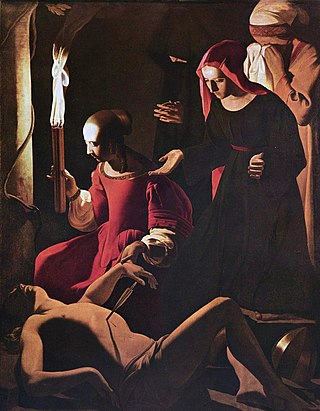
Saint Sebastian Tended by Saint Irene is a c. 1634–1643 oil-on-canvas painting of Saint Sebastian having his wounds tended by Saint Irene, which suddenly became a popular subject in the 1620s. It is now in the Gemäldegalerie, Berlin.

The Newborn Child is an oil-on-canvas painting created c. 1645–1648 by the French painter Georges de La Tour, now in the Museum of Fine Arts of Rennes in France. It is sometimes thought to be a representation of the Madonna and Child in the form of a genre scene – it is thus also known as The Nativity.

The Hurdy-Gurdy Player is an oil-on-canvas painting by Georges de La Tour. The artist neither signed nor dated it, but it was produced in the first phase of his career, probably between 1620 and 1625. It is also known as The Hurdy-Gurdy Player in a Hat or The Hurdy-Gurdy Player with a Fly. It is now in the Musée d'Arts de Nantes.

The Adoration of the Shepherds is a 1644 oil-on-canvas painting by the French artist Georges de La Tour. It is now in the Louvre Museum, in Paris, which purchased it in 1926.

Magdalene with Two Flames or The Penitent Magdalene is an undated oil-on-canvas painting created c.1640 by the French painter Georges de La Tour. In 1978 Mr. and Mrs. Charles Wrightsman gave it to the Metropolitan Museum of Art in New York, where it still hangs.
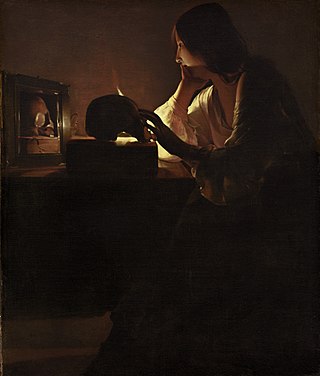
Magdalene at a Mirror or The Repentant Magdalene is a c.1635-1640 oil-on-canvas painting by the French artist Georges de La Tour. It passed from the Marquise de Caulaincourt to the Comtesse d'Andigné in 1911, before being bought in 1936 by André Fabius – it is sometimes known as The Fabius Magdalene as a result. It was then unattributed but Louvre experts attributed it to de la Tour in 1937. Fabius could not find a buyer in France and so in 1964 sold it to the National Gallery of Art in Washington, where it still hangs, though this caused a legal case since Fabius had not sought an export licence to remove the work from France.
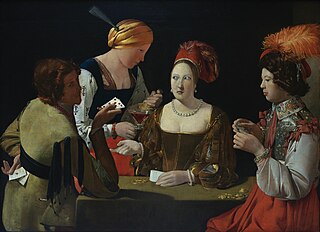
The Card Sharp with the Ace of Diamonds is an oil-on-canvas painting produced c. 1636–1638 by the French artist Georges de La Tour. It is now in the Louvre, which bought it in 1972. Though its commissioner is unknown, it is signed Georgius De La Tour fecit under the card sharp's elbow and in the shadow of the tablecloth.

The Fortune Teller, also known as the Fortune Teller with Soldiers, is an oil on canvas painting dating to approximately 1620 by French painter, Valentin de Boulogne, a follower of Caravaggio. It is now held in the Toledo Museum of Art, in Toledo, Ohio. The scene depicts a group of men around a fortune teller that was attributed by Gustav Friedrich Waagen.



















